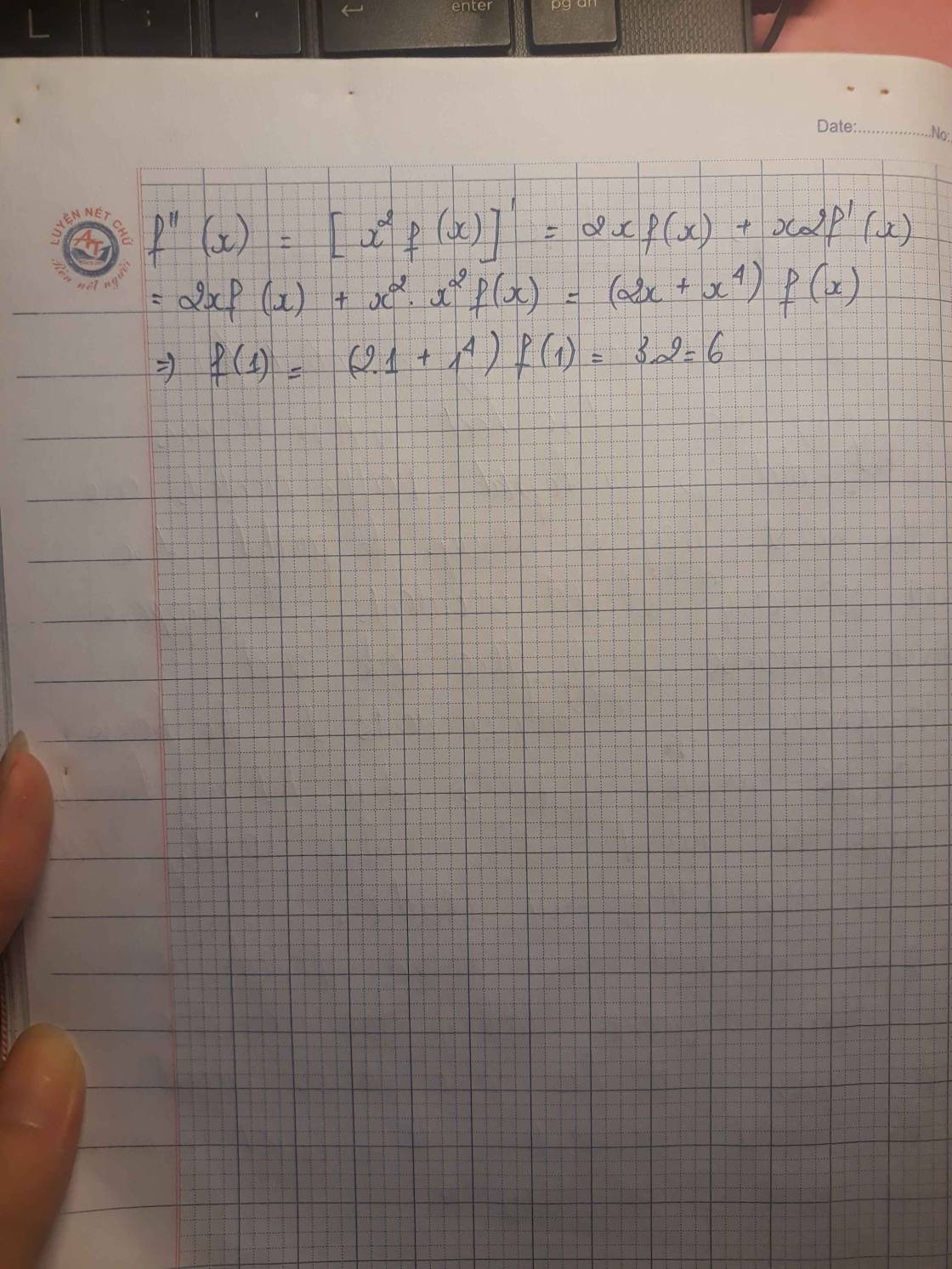

Hãy nhập câu hỏi của bạn vào đây, nếu là tài khoản VIP, bạn sẽ được ưu tiên trả lời.



\(f\left(x+3\right)=g\left(x\right)+x^2-10x+5\)
\(\Rightarrow f'\left(x+3\right)=g'\left(x\right)+2x-10\)
Thế \(x=1\) ta được:
\(f'\left(4\right)=g'\left(1\right)-8\)
\(\Rightarrow g'\left(1\right)=f'\left(4\right)+8=13\)

Thế \(\left(x;y\right)=\left(0;-1\right)\) vào ta được \(f\left(0\right)=0\)
Thế \(y=0\Rightarrow f\left(f\left(x\right)\right)=x\)
Do vế phải của biểu thức trên là hàm bậc nhất \(\Rightarrow\) có tập giá trị là \(Z\Rightarrow f\) là toàn ánh
Giả sử tồn tại \(x_1;x_2\) sao cho \(f\left(x_1\right)=f\left(x_2\right)=a\Rightarrow\left\{{}\begin{matrix}f\left(f\left(x_1\right)\right)=x_1\Rightarrow f\left(a\right)=x_1\\f\left(f\left(x_2\right)\right)=x_2\Rightarrow f\left(a\right)=x_2\end{matrix}\right.\)
\(\Rightarrow x_1=x_2\Rightarrow f\) là đơn ánh \(\Rightarrow f\) là song ánh
Thế \(\left(x;y\right)=\left(1;-1\right)\Rightarrow f\left(0\right)=1+f\left(-1\right)\Rightarrow f\left(-1\right)=-1\)
Thế \(\left(x;y\right)=\left(-1;f\left(1\right)\right)\Rightarrow f\left(f\left(-1\right)+f^2\left(1\right)\right)=-1+f\left(f\left(1\right)\right)\)
\(\Rightarrow f\left(f^2\left(1\right)-1\right)=-1+1=0\Rightarrow f^2\left(1\right)-1=0\) (do \(f\) song ánh)
\(\Rightarrow f^2\left(1\right)=1\Rightarrow f\left(1\right)=1\) (cũng vẫn do \(f\) song ánh nên \(f\left(1\right)\ne-1\) do \(f\left(-1\right)=-1\))
Thế \(\left(x;y\right)=\left(1;x\right)\Rightarrow f\left(1+x\right)=1+f\left(x\right)\) (1)
Từ đẳng thức trên, do \(x\in Z\) nên ta có thể quy nạp để tìm hàm \(f\):
- Với \(x=0\Rightarrow f\left(1\right)=1\)
- Với \(x=1\Rightarrow f\left(2\right)=f\left(1+1\right)=1+f\left(1\right)=2\)
- Giả sử \(f\left(k\right)=k\), ta cần chứng minh \(f\left(1+k\right)=1+k\), nhưng điều này hiển nhiên đúng theo (1)
Vậy \(f\left(x\right)=x\) là hàm cần tìm

Chẳng hạn  .
.
Dễ dàng kiểm tra được rằng f(x) thoả mãn các điều kiện đã nêu

Bài 1:
Cho $y=0$ thì: $f(x^3)=xf(x^2)$
Tương tự khi cho $x=0$
$\Rightarrow f(x^3-y^3)=xf(x^2)-yf(y^2)=f(x^3)-f(y^3)$
$\Rightarrow f(x-y)=f(x)-f(y)$ với mọi $x,y\in\mathbb{R}$
Cho $x=0$ thì $f(-y)=0-f(y)=-f(y)$
Cho $y\to -y$ thì: $f(x+y)=f(x)-f(-y)=f(x)--f(y)=f(x)+f(y)$ với mọi $x,y\in\mathbb{R}$
Đến đây ta có:
$f[(x+1)^3+(x-1)^3]=f(2x^3+6x)=f(2x^3)+f(6x)$
$=2f(x^3)+6f(x)=2xf(x^2)+6f(x)$
$f[(x+1)^3+(x-1)^3]=f[(x+1)^3-(1-x)^3]$
$=(x+1)f((x+1)^2)-(1-x)f((1-x)^2)$
$=(x+1)f(x^2+2x+1)+(x-1)f(x^2-2x+1)$
$=(x+1)[f(x^2)+2f(x)+f(1)]+(x-1)[f(x^2)-2f(x)+f(1)]$
$=2xf(x^2)+4f(x)+2xf(1)$
Do đó:
$2xf(x^2)+6f(x)=2xf(x^2)+4f(x)+2xf(1)$
$2f(x)=2xf(1)$
$f(x)=xf(1)=ax$ với $a=f(1)$

\(f\left(x^5+y^5+y\right)=x^3f\left(x^2\right)+y^3f\left(y^2\right)+f\left(y\right)\)
Sửa lại đề câu 2 !!

Do \(\lim\limits_{x\rightarrow3}\dfrac{f\left(x\right)-2}{x-3}\) hữu hạn \(\Rightarrow f\left(x\right)-2=0\) có nghiệm \(x=3\)
Hay \(f\left(3\right)-2=0\Rightarrow f\left(3\right)=2\)
\(\Rightarrow I=\lim\limits_{x\rightarrow3}\left(\dfrac{f\left(x\right)-2}{x-3}\right).\dfrac{1}{\sqrt{5f\left(x\right)+6}+1}=\dfrac{1}{4}.\dfrac{1}{\sqrt{5.f\left(3\right)+6}+1}\)
\(=\dfrac{1}{4}.\dfrac{1}{\sqrt{5.2+6}+1}=\dfrac{1}{20}\)

Lời giải:
Từ $f(1+3x)=2x-f(1-2x)$ thay $x=0$ suy ra $f(1)=1$
$f(1+3x)=2x-f(1-2x)$
$\Rightarrow f'(1+3x)=(2x)'-f'(1-2x)$
$\Leftrightarrow 3f'(1+3x)=2+2f'(1-2x)$. Thay $x=0$ suy ra $f'(1)=2$
PTTT của $f(x)$ tại điểm $x=1$ là:
$y=f'(1)(x-1)+f(1)=2(x-1)+1=2x-1$

1.
\(f'\left(x\right)=3x^2-6mx+3\left(2m-1\right)\)
\(f'\left(x\right)-6x=3x^2-3.2\left(m+1\right)x+3\left(2m-1\right)>0\)
\(\Leftrightarrow x^2-2\left(m+1\right)x+2m-1>0\)
\(\Leftrightarrow x^2-2x-1>2m\left(x-1\right)\)
Do \(x>2\Rightarrow x-1>0\) nên BPT tương đương:
\(\dfrac{x^2-2x-1}{x-1}>2m\Leftrightarrow\dfrac{\left(x-1\right)^2-2}{x-1}>2m\)
Đặt \(t=x-1>1\Rightarrow\dfrac{t^2-2}{t}>2m\Leftrightarrow f\left(t\right)=t-\dfrac{2}{t}>2m\)
Xét hàm \(f\left(t\right)\) với \(t>1\) : \(f'\left(t\right)=1+\dfrac{2}{t^2}>0\) ; \(\forall t\Rightarrow f\left(t\right)\) đồng biến
\(\Rightarrow f\left(t\right)>f\left(1\right)=-1\Rightarrow\) BPT đúng với mọi \(t>1\) khi \(2m< -1\Rightarrow m< -\dfrac{1}{2}\)
2.
Thay \(x=0\) vào giả thiết:
\(f^3\left(2\right)-2f^2\left(2\right)=0\Leftrightarrow f^2\left(2\right)\left[f\left(2\right)-2\right]=0\Rightarrow\left[{}\begin{matrix}f\left(2\right)=0\\f\left(2\right)=2\end{matrix}\right.\)
Đạo hàm 2 vế giả thiết:
\(-3f^2\left(2-x\right).f'\left(2-x\right)-12f\left(2+3x\right).f'\left(2+3x\right)+2x.g\left(x\right)+x^2.g'\left(x\right)+36=0\) (1)
Thế \(x=0\) vào (1) ta được:
\(-3f^2\left(2\right).f'\left(2\right)-12f\left(2\right).f'\left(2\right)+36=0\)
\(\Leftrightarrow f^2\left(2\right).f'\left(2\right)+4f\left(2\right).f'\left(2\right)-12=0\) (2)
Với \(f\left(2\right)=0\) thế vào (2) \(\Rightarrow-12=0\) ko thỏa mãn (loại)
\(\Rightarrow f\left(2\right)=2\)
Thế vào (2):
\(4f'\left(2\right)+8f'\left(2\right)-12=0\Leftrightarrow f'\left(2\right)=1\)
\(\Rightarrow A=3.2+4.1\)

\(\lim\limits_{x\rightarrow1^+}f\left(x\right)=\lim\limits_{x\rightarrow1^-}f\left(x\right)\Rightarrow\lim\limits_{x\rightarrow1}f\left(x\right)=2\)